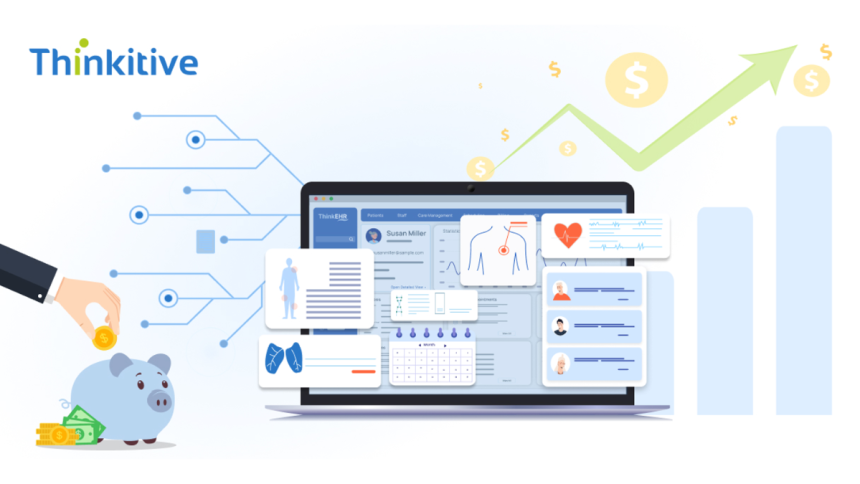Your EHR integration might be costing you more than you realize if it’s not a custom EHR integration solution.
Many healthcare organizations invest in off-the-shelf integration solutions; however, these solutions, despite being good, provide limited options and, most importantly, do not align with specific workflows and operations.
Over time, as your practice expands, these limitations create inefficiencies such as duplicate data entries, care coordination delays, and billing errors. These challenges seem minor at the start, but with time, they add up quickly and cost you both time and money.
But even with these glaring and well-known problems, organizations hesitate to invest in custom EHR integration solutions. And it’s understandable as it needs significant upfront investment, and this is what stops the financial teams from putting in their money.
However, custom EHR integration opens doors that off-the-shelf solutions never can. Instead, they keep your organization bleeding for money and time. With tailored integration solutions, new revenue streams such as quality achievement bonuses and clinical research become available.
This is why custom EHR integration often delivers more financial outcomes than seemingly cheaper alternatives. So, instead of seeing it as an expensive solution, view it as a strategic investment to drive value and revenue in the long term.
This blog will give you a complete understanding of why custom EHR integration is better than traditional off-the-shelf software, along with walking you through the methods for planning a healthcare integration budget properly.
The Hidden Costs of Generic Integration Solutions
Generic integration solutions work best with generic workflows, but you lose staff productivity if they aren’t aligned with your specific workflows. And then comes a time when you need to find workarounds for everything, resulting in increased manual work and data entry, as well as creating duplicate documents and process gaps.
Moreover, maintaining these solutions costs you more money. Also, you become dependent on a single vendor and, for support, need to pay extra costs without the option of going to another vendor. And the consequences are not only limited to this; it also causes revenue losses with inefficient medical charge capture during billing.
Expanding becomes a tough task as these solutions fail to scale along with your organization due to limited flexibility and customization availability. It also limits you when you want to adopt new technologies in the solutions.
The generic integration solutions do not have the capability to evolve with rapidly changing regulations, and this can mean hefty fines when inspected. And if you want to protect patient data with generic solutions that do not fit your workflows, it can also create vulnerabilities, risking patient data safety.
So, implementing generic integration solutions can save you money in the short term, but it costs you much more in the long run.
Custom EHR Integration: Investment vs Expense Analysis
When you compare custom EHR integration solutions with generic ones, it may seem expensive, but within three to five years, this changes completely. Although custom EHR integration has high initial costs, you own the software completely, and with generic solutions, you need a subscription fee, which can increase in the future.
Maintenance costs are much lower for custom solutions as it is built to fit your needs. Moreover, a custom EHR integration can grow with your practice, which means that with every change, you don’t need to scrap everything and build again.
As I said earlier, custom integration solutions are built for your needs and match how your team actually works. This saves a lot of time for your staff as they find everything in a single place and don’t need to jump between systems. Additionally, from scheduling to billing, custom automation helps the staff work faster and smarter.
Custom EHR integration not only saves money but also helps in generating more revenue. When your EHR integration solution knows how your billing system works, it is less likely to miss charges. Getting pre-authorization is much simpler than generic solutions, as it fast-tracks this process based on your clinical workflows and payers.
With custom EHR integration, you can quickly adapt to new changes and easily plug in new tools and features like AI and telehealth. This saves you the cost of rebuilding everything to upgrade your integration solutions.
Strategic Financial Benefits: Beyond Cost Reduction
The benefits of having a custom EHR integration do not end at just saving you time and money. A custom integration opens new ways to make money, lowers risks, and strengthens your position in a competitive market.
With a custom EHR integration, you can easily open a new service line and increase your revenue options without losing operational efficiency. Doing clinical research and trials requires specific data tracking and custom solutions. You can build exactly what researchers need and get paid to participate.
A custom integration saves you from heart compliance fines and legal risks. With better integration, you get excellent decision support, which means fewer medical errors and fewer malpractice premium costs. Similarly, with a custom security implementation system remaining well-protected from cyber attacks, you need to pay lower cybersecurity insurance.
When you have smoother and more streamlined workflows than your competitors, it attracts more talent to your practice. Also, with better care coordination, patient experience improves, resulting in increased patient loyalty and retention.
And finally, a custom solution is not just for completing today’s needs. It also gives you the foundations to evolve with the changing healthcare landscape. You can use remote monitoring with telehealth, track patient outcomes, and succeed in contracts that reward quality, not just volume.
Healthcare Integration Budget Planning: Making the Financial Case
When you need to get a healthcare integration budget approved, you need to position custom EHR integration as a strategic advantage rather than an IT expense. In the presentation, there are long-term benefits such as improved care delivery and better staff productivity.
Give a budget of three to five years showing how the initial investment can be recovered with increased revenue. Moreover, it is structured in a way that supports cash flow, tax advantages, and budget flexibility. Break down the project into phases, spreading overall costs, reducing risks, and starting to see benefits earlier.
Along with this, explore different cost models of vendors, as custom integration does not always need all payments upfront. There are models like milestone-based payment, where you pay as each piece of value is delivered. Every vendor has different options, so explore those before finalizing the healthcare integration budget.
Custom EHR integration benefits multiple departments. Show that in your budgeting, and the ROI tracking also reflects that. Building incentive structures so that departments are motivated to adopt and optimize the new systems and not resist them.
Implementing Financial Management & Success Optimization
The real challenge of custom EHR integration comes after you get approval for the healthcare integration budget. You need to manage wisely to make sure it delivers everything promised after the implementation.
For that, you need to start by maintaining strong financial controls, and it starts with choosing financial models. For instance, a fixed price model may be predictable, but a time-and-material model gives you more flexibility. Choosing the right structure depends on how complex your custom EHR integration is.
Some changes might derail the project, but some changes may add solid value. For example, developing a custom EHR software makes the whole integration process much better. However, just implementing the custom EHR integration solution is not enough; you also need to measure how well it is working financially.
For that, define key performance indicators like cost saving and revenue growth, and track them continuously to know improvements and financial returns. Continuous optimization is also needed to keep custom EHR integration updated with evolving technology and regulations.
Finally, remember that even a well-planned project can face some unexpected risks, so identify those risks and plan for them so the project does not get severely affected. Build guarantees in vendor contracts whenever possible to secure their support and accountability.
Conclusion
In a nutshell, custom EHR integration may seem costly initially, but it gives guaranteed returns and costs less in the long run. However, a less expensive alternative may seem cheaper at first, but the cost goes higher later on, and it also limits the future growth of your organization.
So, a custom EHR integration is a strategic investment rather than a costly IT initiative. And implement it to gain financial, operational, and competitive advantage while being ready for every change in the healthcare landscape.
Frequently Asked Questions
1. How does the total cost of ownership compare between custom and off-the-shelf EHR integration over 5 years?
Over the course of 5 years, custom EHR integration generally incurs a higher upfront cost but often results in a lower total cost of ownership (TCO) due to the absence of recurring licensing fees and optimal workflow alignment. Off-the-shelf solutions have lower initial costs but incur higher total cost of ownership (TCO) through ongoing licensing, customization, and potential integration fees.
2. What is the typical ROI timeline for custom EHR integration investments?
The timeline for ROI in custom EHR integration is different for every healthcare organization. Some studies suggest clinics recover investments in around 10 months. However, complex projects with extensive customization and integration can take 1-2.5 years or more to show a significant return on investment (ROI) as benefits accrue through improved efficiency and cost reduction over time.
3. How can healthcare organizations justify the higher upfront costs of custom integration to their board?
Healthcare organizations can justify custom integration by demonstrating its long-term ROI through increased efficiency, reduced operational costs, enhanced patient safety and outcomes, and improved regulatory compliance. It eliminates workarounds, boosts staff productivity, and offers scalability that off-the-shelf solutions lack, ultimately leading to greater financial sustainability.
4. What financial metrics should be tracked to measure custom integration success?
To measure the success of custom integration, key financial metrics to track include Return on Investment (ROI), total cost of ownership (TCO) reduction, operational efficiency gains such as reduced manual effort and faster data processing, and revenue impact from new capabilities or improved customer experience.
5. How do custom integration solutions impact operational efficiency and cost reduction?
Custom integration solutions enhance operational efficiency by automating manual tasks, streamlining workflows, and improving data accuracy across systems. This leads to reduced errors, faster processes, and better decision-making. Consequently, businesses experience significant cost reductions from decreased labor, minimized rework, and optimized resource allocation.
6. What are the hidden costs of generic integration solutions that organizations often overlook?
Healthcare organizations often overlook hidden costs, such as:
- Maintenance and Update Cost
- Scalability Limitations
- Security Gaps
- Performance Bottlenecks
- Lack of Customization
7. How can smaller healthcare organizations afford custom EHR integration solutions?
If smaller healthcare organizations want to build custom EHR integration, they can do so by prioritizing essential integrations, utilizing cloud-based EHRs with APIs, using phased implementation, exploring government grants or incentives, and negotiating with vendors for various payment models.8.
8. What financing options are available for custom healthcare integration projects?
Financing options for custom healthcare integration projects include traditional bank loans, equipment financing, and lines of credit. Specialized healthcare IT financing companies, venture capital, and government grants or public health initiatives also provide significant funding, particularly for innovative or interoperability-focused projects.
9. How does custom integration support revenue enhancement and new business opportunities?
Custom integration streamlines processes, improves data flow, and enhances customer experiences, directly leading to increased efficiency and better decision-making. This fosters higher sales, improved customer retention, and the agility to pursue new market ventures, ultimately boosting revenue and unlocking new business opportunities.
10. What risk factors should be considered in the financial analysis of custom vs. generic integration?
For custom integration, consider higher upfront costs, longer development time, vendor dependency, and potential for scope creep. Generic integration risks include limited customization, integration complexities with existing systems, ongoing licensing fees, and a potential lack of specific functionality for unique business needs.
11. How do regulatory compliance costs differ between custom and generic integration approaches?
Custom integration typically incurs higher upfront and ongoing costs for regulatory compliance due to bespoke development, extensive testing, and manual updates for each system. Generic integration, often utilizing standardized platforms, such as iPaaS, typically offers lower, more predictable compliance costs through built-in features, automated updates, and centralized management.
12. What long-term financial benefits do custom integration solutions provide beyond initial implementation?
Beyond initial setup, custom integration solutions provide long-term financial benefits by boosting efficiency through automation, reducing manual errors and associated costs, improving data accuracy for better decision-making, enabling scalability for future growth without expensive overhauls, and fostering a competitive advantage through tailored processes.
Lynn Martelli is an editor at Readability. She received her MFA in Creative Writing from Antioch University and has worked as an editor for over 10 years. Lynn has edited a wide variety of books, including fiction, non-fiction, memoirs, and more. In her free time, Lynn enjoys reading, writing, and spending time with her family and friends.















